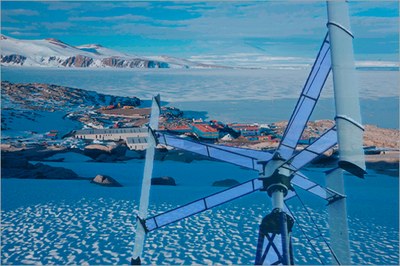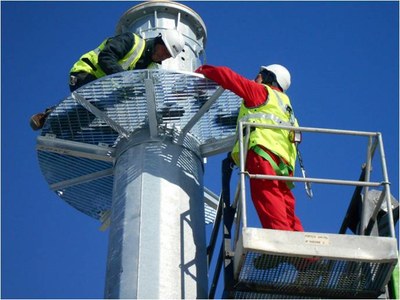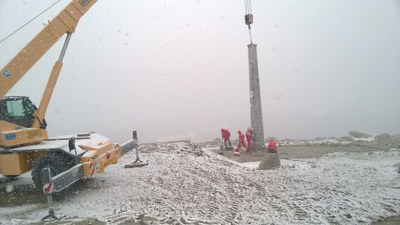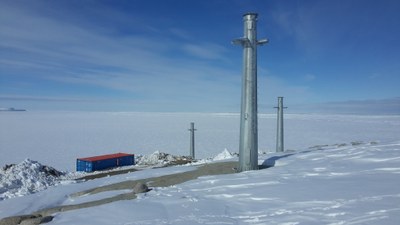Energy: First wind farm at Italian station in Antarctica
22/12/2017
 Wind is again the protagonist in Antarctica. Not only as a driving force of climate”, but as the engine of the first wind farm built at the Italian Mario Zucchelli Station in Terra Nova Bay, housing since 1985 the scientific laboratory of the PNRA, the National research program in Antarctica, funded by the MIUR, with the logistic implementation of ENEA and the scientific coordination of the CNR.
Wind is again the protagonist in Antarctica. Not only as a driving force of climate”, but as the engine of the first wind farm built at the Italian Mario Zucchelli Station in Terra Nova Bay, housing since 1985 the scientific laboratory of the PNRA, the National research program in Antarctica, funded by the MIUR, with the logistic implementation of ENEA and the scientific coordination of the CNR.
Designed and built by ENEA, the wind farm will exploit the strong katabatic winds for producing approximately 63thousand kWh of electricity per year with significant environmental and economic benefits, thanks to annual savings of at least 24thousand litres of fuel and of almost 80thousand euro in the “bill”.
“This wind farm- Sergio Sgroi at ENEA, explained-is a logistic upgrade made possible thanks to the Engineering Service of the ENEA Antarctic Technical Unit, which supervised the project analysis, the installation and the interconnecting works between the plant and the endothermic system, currently fed by Jet A-1, a specific kerosene fossil fuel added with an anti-icing inhibitor”.
The plant consists of 3 ten –meter- high wind generators, each made of a seven- meter rotor and 5- meter, horizontal axis, three-blades wind turbines. The construction works began in 2015 and will conclude with an experimental start-up during the current summer campaign, the XXXIII of the PNRA. Once in operation, the three wind towers will cover the electric energy need of the Italian Station during the entire anctartic winter.
“In the winter season - Sgroi went on – the Italian Station empties, so the energy need is reduced, but it’s nevertheless fundamental to keep in operation satellite communication systems, science and weather stations and provide heating for some premises used for storing sensitive equipment.
 During the long Antarctic winter the endothermic system of the station will be in standby mode, becoming active in emergency situations or to compensate the variability of wind energy generation.
During the long Antarctic winter the endothermic system of the station will be in standby mode, becoming active in emergency situations or to compensate the variability of wind energy generation.
During summer, the energy need of the station reaches definitely higher values (around 200 KWh), so the wind farm works in parallel with the fossil fuel plant. “At the moment - Sgroi concluded- it’s not possible to quit fossil fuel and rely solely on wind energy for electricity production, due to the great instability of Antarctic winds, which aren’t always productive for energy purposes, because absent or either too light or too strong for the mechanical resistance limits of wind turbines”.
For the plant, provided by Ropatec srl in Bolzano in collaboration with Studio Bissanti, specific materials and technical solutions for particularly cold weather were chosen, were shipped to the station by the oceanographic motor vessel Italica during the crossings of the last two Antarctic campaigns. The site was chosen and the foundations laid following a georadar survey taken by geologists at the Mario Zucchelli Station. But the biggest technological challenge is the safety of operation of the windfarm during the Antarctic winter, in the absence of supervision.
 “We’re studying the possibility of developing a monitoring and remote control system – Francesco Pellegrini at ENEA, explained – to ensure the optimization of functional parameters, a proper management of the alarm system and possible safety works in the case of malfunctioning or technical failure”.
“We’re studying the possibility of developing a monitoring and remote control system – Francesco Pellegrini at ENEA, explained – to ensure the optimization of functional parameters, a proper management of the alarm system and possible safety works in the case of malfunctioning or technical failure”.
Other difficulties intrinsic to the management of the wind farm are related to the extreme conditions of the site, characterized by strong katabatic winds and low winter temperatures, with a seasonal minimum up to -40°C, which can cause ice formation on wind blades and other components of the rotor. “Katabatic winds, which sink down from the Antarctic plateau towards the coast, with speeds sometimes in excess of 100 knots (185 Km/h), have a destructive potential which cannot be ignored.
All this - Pellegrino went on- has forced us to conduct an accurate project evaluation of the mechanical structure and the moving parts, particularly of the choice of materials, size of components and foundation works”.
Italy is aligning with sustainable development solutions which have become standards in some international arctic stations, where several wind farms have been in operation for some years, meeting the challenge of bringing advanced technologies in areas that have until recently been considered too hostile and difficult to exploit for renewable energy sources.
For more information please contact:
Sergio Sgroi, ENEA – Engineering Service of the Antarctic Technical Unit, sergio.sgroi@enea.it
Francesco Pellegrino, ENEA – Engineering Service of the Antarctic Technical Unit, francesco.pellegrino@enea.it
Umberto Ponzo, ENEA – Head Engineering Service of the Antarctic Technical Unit, umberto.ponzo@enea.it

